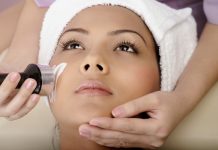Have you ever heard of a disease that probably got its name from a flower? Rosacea is a long-term disease that is not curable. It is characterized by reddish and pinkish patches in the face.
Sometimes, small red bumps and eye irritation are known visible symptoms. Don’t you think it was probably named that way because it is likened to those reddish rose buds?
Believe it or not but this disease affects at least 14 million people in the United States.
However, most of those with rosacea may not even be aware that they have it thinking that the reddish color is an indication of blushing.
Try to take a look at Former Pres. Bill Clinton. See those red patches on his face? Of course he is not blushing. He has rosacea.
There are many different kinds of rosacea treatments available. However, foremost of all it is important to see a dermatologist.
The earlier the disease is diagnosed, the more rosacea treatments are available. This can also help control the growth of symptoms. Rosacea treatments done on the earlier stages may abort the disease from progressing.
Rosacea treatments begin with the dermatologist’s analysis and evaluation of the subtype of rosacea that appears on the patient’s skin. This is crucial because certain rosacea treatments are applicable to a given subtype only.
This disease as earlier mentioned is not curable and the condition is long term in nature. However, this can be controlled and symptoms regulated with the appropriate rosacea treatments available. Here are some of its effective treatments:
Photodynamic therapy
You may want to know how a photodynamic therapy works. In photodynamic therapy, a photo sensitizer liquid is applied to activate the sensitizer that regulates inflammation and improves the skin texture. Mild discomfort and moderate sunburn appearance are among the side effects.
Considered as one of the newest rosacea treatments to hit the market, most patients have noticed significant relief and improvement. Talk about technology and medical breakthroughs.
Oral and topical medicines
Taking prescribed medicines, either oral or topical, is also one of the rosacea treatments available. However, be wary of over-the-counter medicines as they may irritate the skin and further aggravate the condition. Likewise, acne medications may not be used to treat rosacea without prior clearance from your doctor.
Combined treatments
Other choices for rosacea treatments include antibacterial pills, facial wash and pulsed light therapies. These rosacea treatments may also be combined for maximum result. Again, the kind of treatment should be dependent on the severity of the condition.
Such as in the case of mild rosacea that does not require any treatment for as long as the disease is not bothersome to the patient. You see, treatment options are endless and you can take your pick as to what suits you best.
Laser
Recently, a growing number of patients are now considering laser and intense light rosacea treatments. By opting for this kind of treatment, the noticeable blood vessels and continual redness are eliminated. This is also a safer alternative although it may cause discomfort. If discomfort sets in, ice packs and topical anesthetic creams can be very helpful.
Chemical peels
Glycolic acid peels can also control rosacea by professionally applying the chemical for approximately two to five minutes every two to four weeks. This may result to itching, mild stinging and peeling which takes effect after several days.
Most fair-skinned adults are prone to rosacea. Thus, it is also advisable to apply daily sunscreen lotion. In fact, sun avoidance is even more recommended. However, if you want to look fashionably cool and chic why not try wearing wide-brimmed hat and sunscreen.













